Comprehensive Audit Program for Aeris Environmental Ltd Report
VerifiedAdded on 2023/04/21
|10
|1207
|171
Report
AI Summary
This report provides a detailed audit program for Aeris Environmental Ltd, examining the company's financial statements and key accounts. It identifies significant decreases in cash balance and other potential risks, such as interest-bearing securities. The report includes a comprehensive financial analysis using ratio analysis to assess the company's financial position and performance, highlighting volatile trends in profitability and efficiency ratios. It focuses on material account balances like cash, trade receivables, and property, plant, and equipment, along with key assertions for each. The audit steps cover verification of cash books, ledgers, and internal controls, as well as an outline of the sampling plan based on risk assessment and materiality. The document references several auditing sources and provides a thorough framework for auditing Aeris Environmental Ltd's financial activities. This report is designed to help students understand audit procedures, risk assessment, and financial statement analysis.
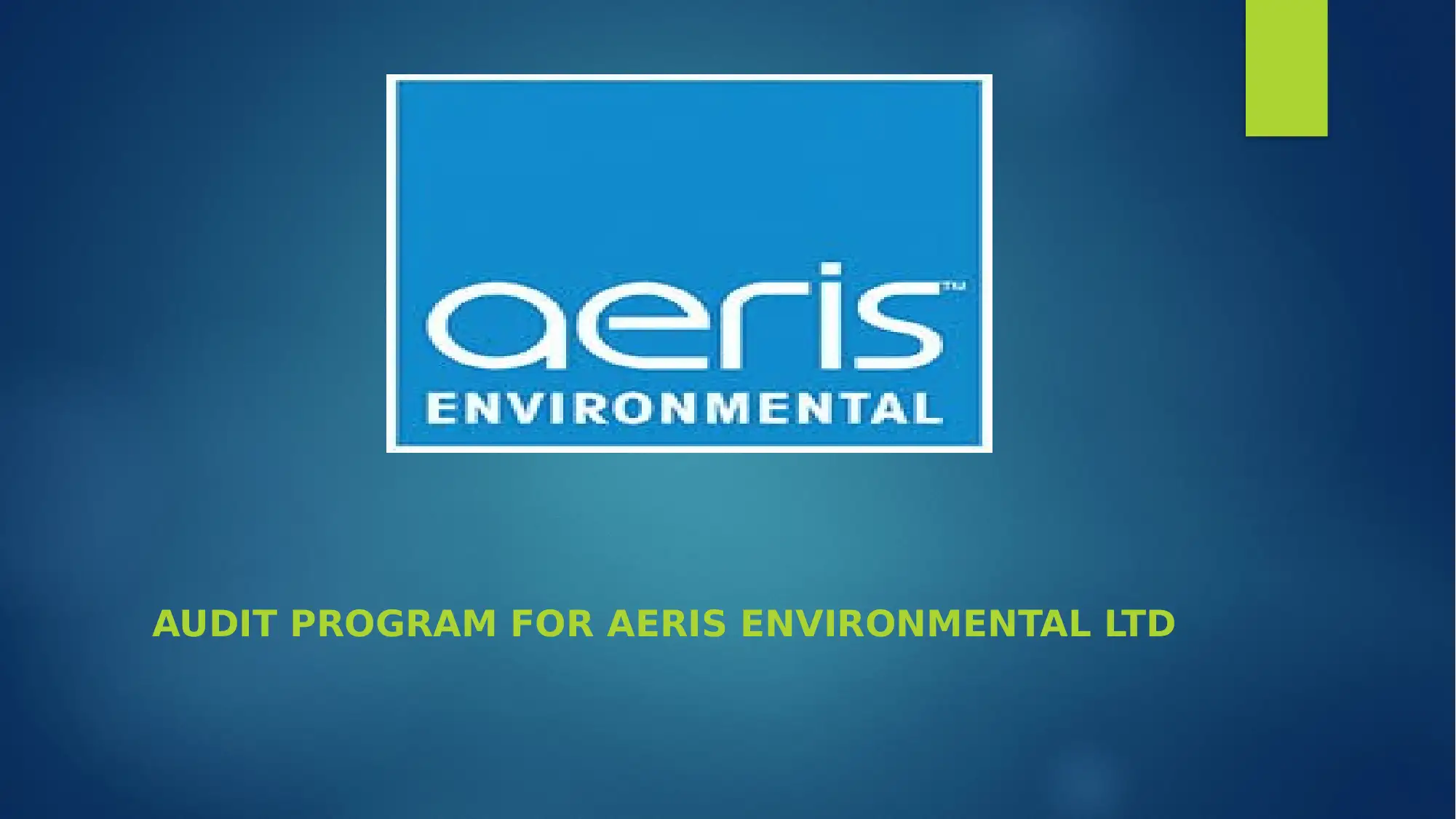
AUDIT PROGRAM FOR AERIS ENVIRONMENTAL LTD
Paraphrase This Document
Need a fresh take? Get an instant paraphrase of this document with our AI Paraphraser
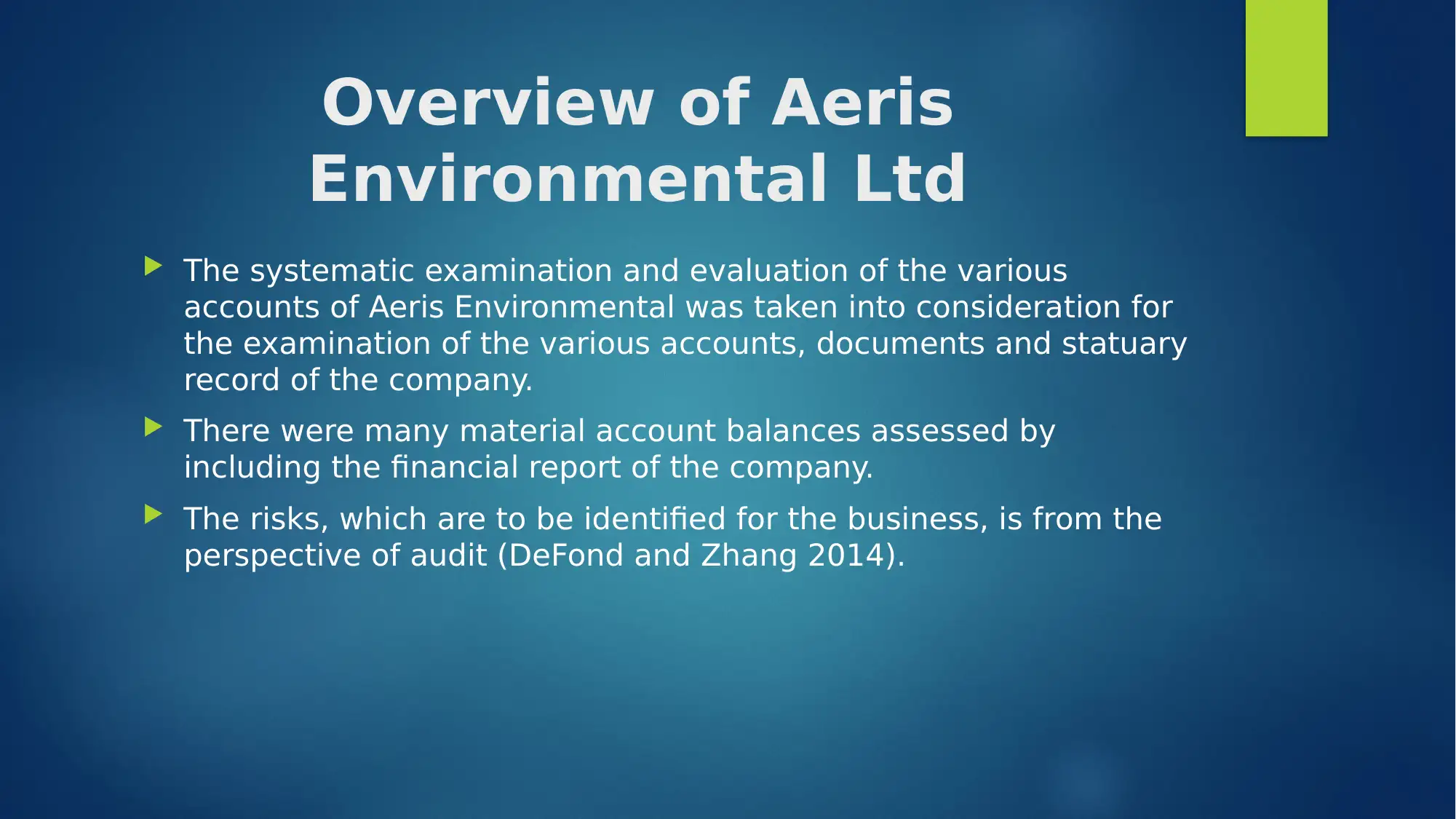
Overview of Aeris
Environmental Ltd
The systematic examination and evaluation of the various
accounts of Aeris Environmental was taken into consideration for
the examination of the various accounts, documents and statuary
record of the company.
There were many material account balances assessed by
including the financial report of the company.
The risks, which are to be identified for the business, is from the
perspective of audit (DeFond and Zhang 2014).
Environmental Ltd
The systematic examination and evaluation of the various
accounts of Aeris Environmental was taken into consideration for
the examination of the various accounts, documents and statuary
record of the company.
There were many material account balances assessed by
including the financial report of the company.
The risks, which are to be identified for the business, is from the
perspective of audit (DeFond and Zhang 2014).
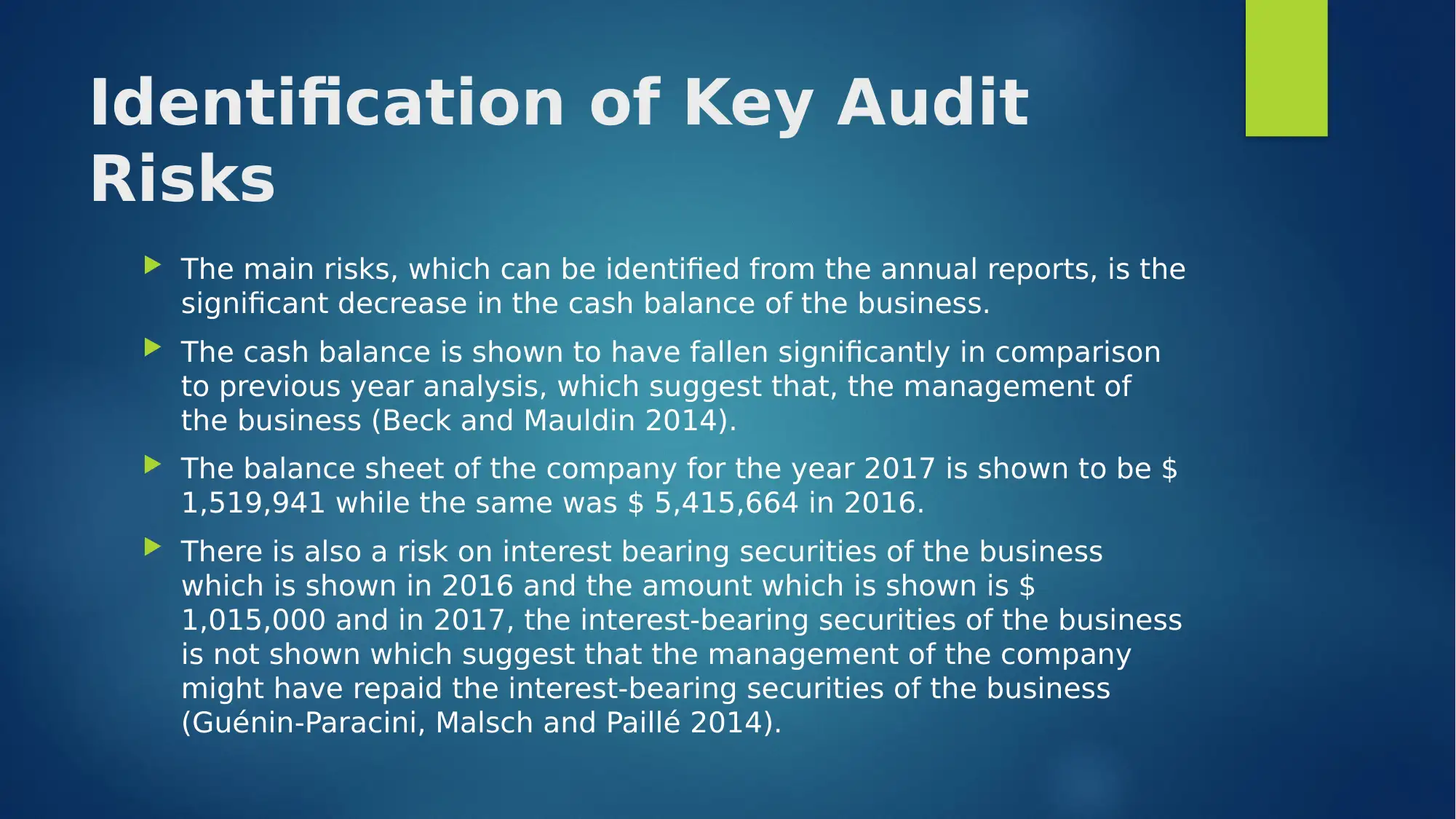
Identification of Key Audit
Risks
The main risks, which can be identified from the annual reports, is the
significant decrease in the cash balance of the business.
The cash balance is shown to have fallen significantly in comparison
to previous year analysis, which suggest that, the management of
the business (Beck and Mauldin 2014).
The balance sheet of the company for the year 2017 is shown to be $
1,519,941 while the same was $ 5,415,664 in 2016.
There is also a risk on interest bearing securities of the business
which is shown in 2016 and the amount which is shown is $
1,015,000 and in 2017, the interest-bearing securities of the business
is not shown which suggest that the management of the company
might have repaid the interest-bearing securities of the business
(Guénin-Paracini, Malsch and Paillé 2014).
Risks
The main risks, which can be identified from the annual reports, is the
significant decrease in the cash balance of the business.
The cash balance is shown to have fallen significantly in comparison
to previous year analysis, which suggest that, the management of
the business (Beck and Mauldin 2014).
The balance sheet of the company for the year 2017 is shown to be $
1,519,941 while the same was $ 5,415,664 in 2016.
There is also a risk on interest bearing securities of the business
which is shown in 2016 and the amount which is shown is $
1,015,000 and in 2017, the interest-bearing securities of the business
is not shown which suggest that the management of the company
might have repaid the interest-bearing securities of the business
(Guénin-Paracini, Malsch and Paillé 2014).
⊘ This is a preview!⊘
Do you want full access?
Subscribe today to unlock all pages.

Trusted by 1+ million students worldwide
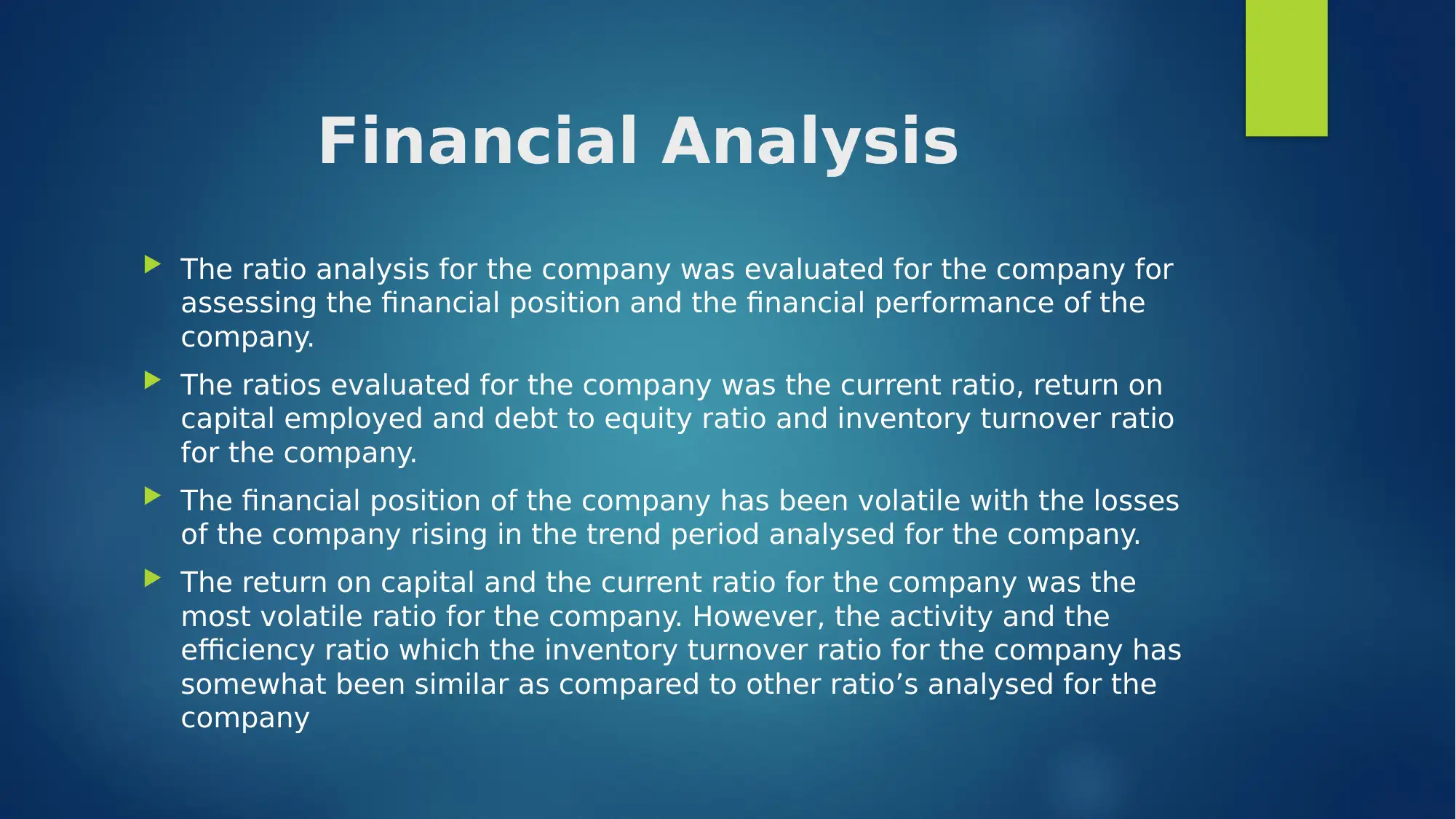
Financial Analysis
The ratio analysis for the company was evaluated for the company for
assessing the financial position and the financial performance of the
company.
The ratios evaluated for the company was the current ratio, return on
capital employed and debt to equity ratio and inventory turnover ratio
for the company.
The financial position of the company has been volatile with the losses
of the company rising in the trend period analysed for the company.
The return on capital and the current ratio for the company was the
most volatile ratio for the company. However, the activity and the
efficiency ratio which the inventory turnover ratio for the company has
somewhat been similar as compared to other ratio’s analysed for the
company
The ratio analysis for the company was evaluated for the company for
assessing the financial position and the financial performance of the
company.
The ratios evaluated for the company was the current ratio, return on
capital employed and debt to equity ratio and inventory turnover ratio
for the company.
The financial position of the company has been volatile with the losses
of the company rising in the trend period analysed for the company.
The return on capital and the current ratio for the company was the
most volatile ratio for the company. However, the activity and the
efficiency ratio which the inventory turnover ratio for the company has
somewhat been similar as compared to other ratio’s analysed for the
company
Paraphrase This Document
Need a fresh take? Get an instant paraphrase of this document with our AI Paraphraser

Material Account Balances
The annual report of Aeris Environmental Company is considered for
identifying the accounts, which are shown in the financial statement,
which can material in nature and can affect the viability of the
financial statements.
In the balance sheet of the company, there has been a significant
fall in the cash account and the sane is shown to be $ 1,519,941
while the balance in 2016 was $ 5,415,664.
The balance of trade receivables is shown to be $ 256,724 and $
434,663 under both the heads of current assets and non-current
assets respectively.
The valuation of property, plant and equipment is a complex process
and therefore the same is considered to be material in nature.
The annual report of Aeris Environmental Company is considered for
identifying the accounts, which are shown in the financial statement,
which can material in nature and can affect the viability of the
financial statements.
In the balance sheet of the company, there has been a significant
fall in the cash account and the sane is shown to be $ 1,519,941
while the balance in 2016 was $ 5,415,664.
The balance of trade receivables is shown to be $ 256,724 and $
434,663 under both the heads of current assets and non-current
assets respectively.
The valuation of property, plant and equipment is a complex process
and therefore the same is considered to be material in nature.
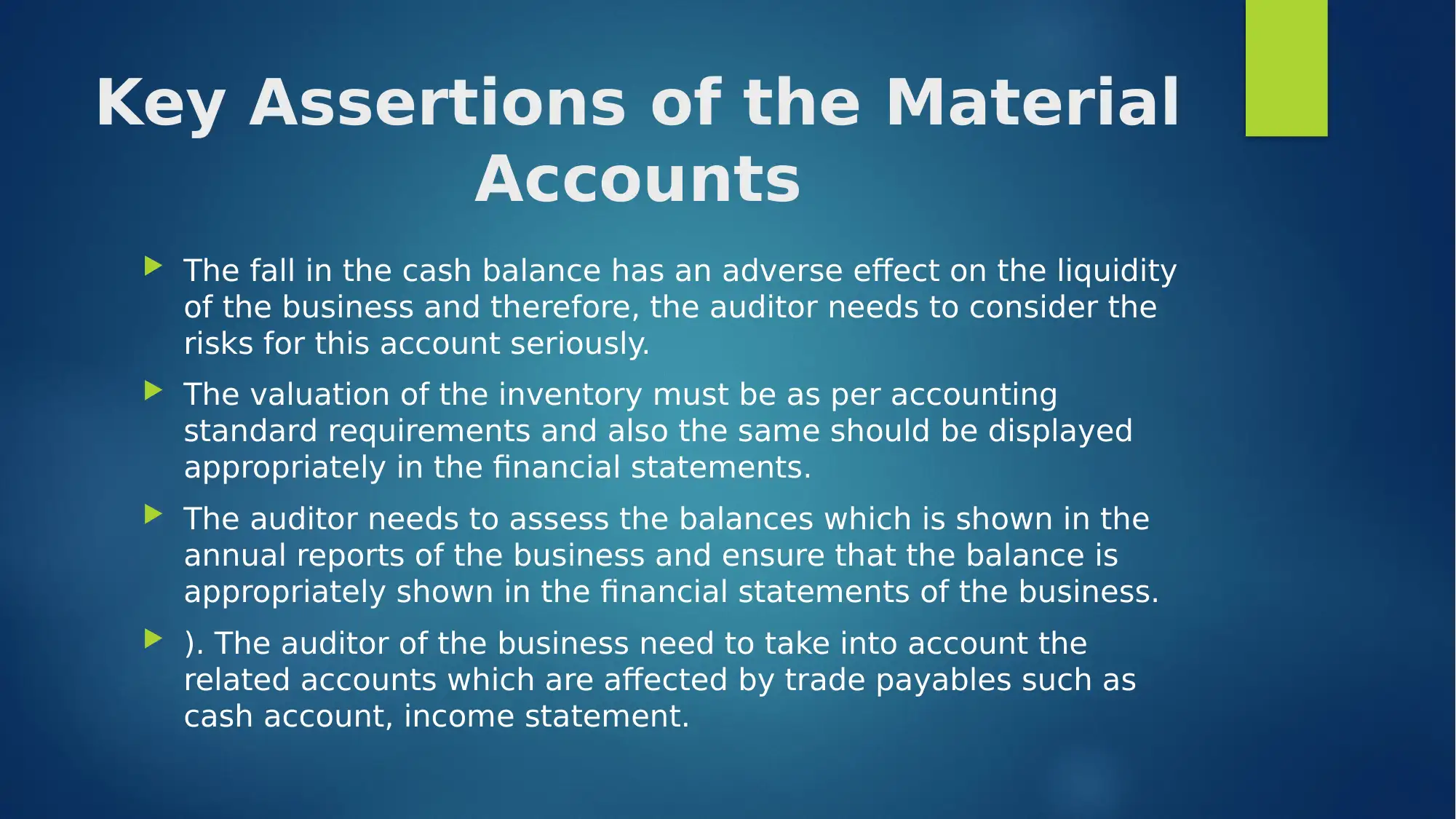
Key Assertions of the Material
Accounts
The fall in the cash balance has an adverse effect on the liquidity
of the business and therefore, the auditor needs to consider the
risks for this account seriously.
The valuation of the inventory must be as per accounting
standard requirements and also the same should be displayed
appropriately in the financial statements.
The auditor needs to assess the balances which is shown in the
annual reports of the business and ensure that the balance is
appropriately shown in the financial statements of the business.
). The auditor of the business need to take into account the
related accounts which are affected by trade payables such as
cash account, income statement.
Accounts
The fall in the cash balance has an adverse effect on the liquidity
of the business and therefore, the auditor needs to consider the
risks for this account seriously.
The valuation of the inventory must be as per accounting
standard requirements and also the same should be displayed
appropriately in the financial statements.
The auditor needs to assess the balances which is shown in the
annual reports of the business and ensure that the balance is
appropriately shown in the financial statements of the business.
). The auditor of the business need to take into account the
related accounts which are affected by trade payables such as
cash account, income statement.
⊘ This is a preview!⊘
Do you want full access?
Subscribe today to unlock all pages.

Trusted by 1+ million students worldwide
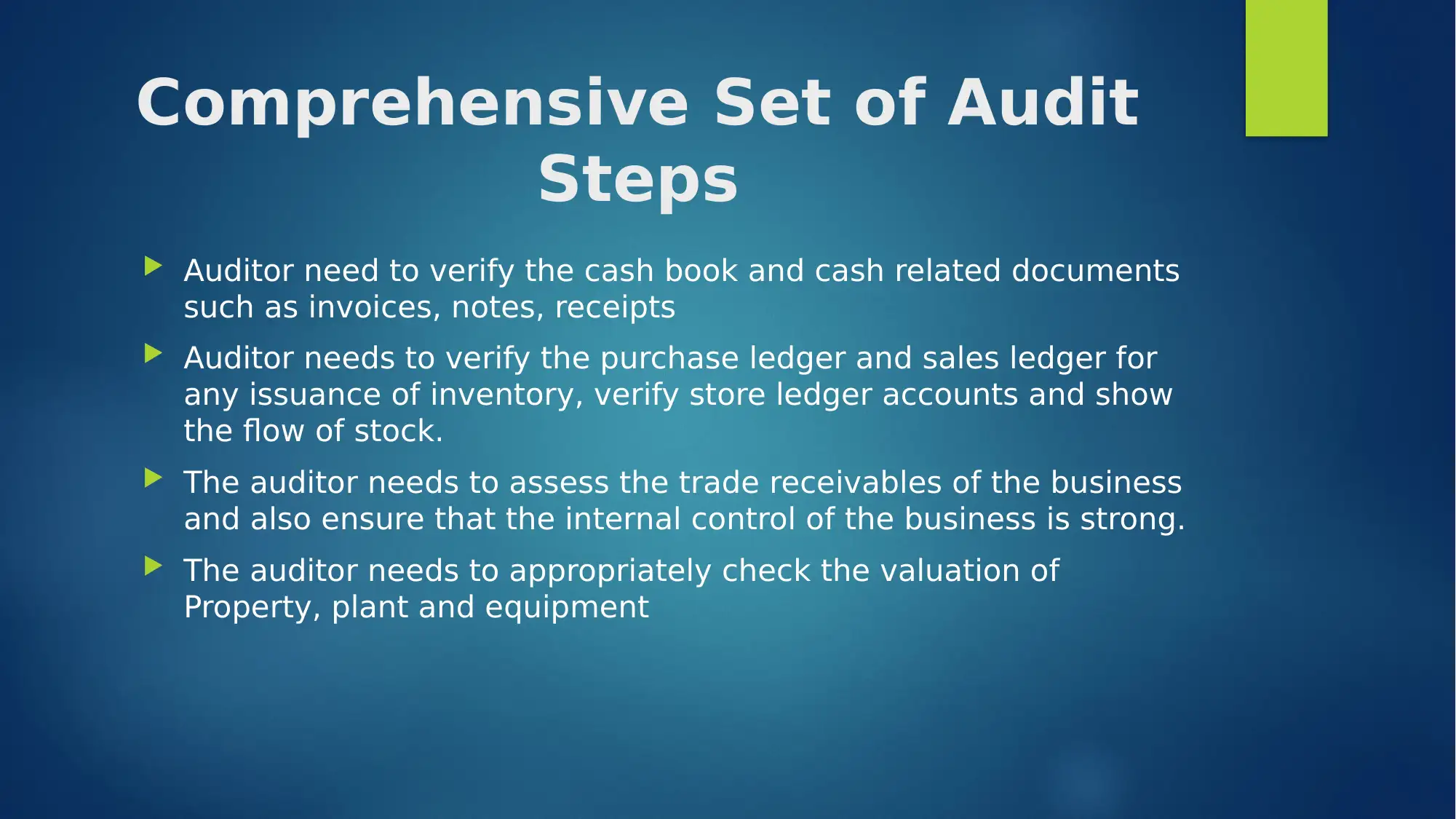
Comprehensive Set of Audit
Steps
Auditor need to verify the cash book and cash related documents
such as invoices, notes, receipts
Auditor needs to verify the purchase ledger and sales ledger for
any issuance of inventory, verify store ledger accounts and show
the flow of stock.
The auditor needs to assess the trade receivables of the business
and also ensure that the internal control of the business is strong.
The auditor needs to appropriately check the valuation of
Property, plant and equipment
Steps
Auditor need to verify the cash book and cash related documents
such as invoices, notes, receipts
Auditor needs to verify the purchase ledger and sales ledger for
any issuance of inventory, verify store ledger accounts and show
the flow of stock.
The auditor needs to assess the trade receivables of the business
and also ensure that the internal control of the business is strong.
The auditor needs to appropriately check the valuation of
Property, plant and equipment
Paraphrase This Document
Need a fresh take? Get an instant paraphrase of this document with our AI Paraphraser
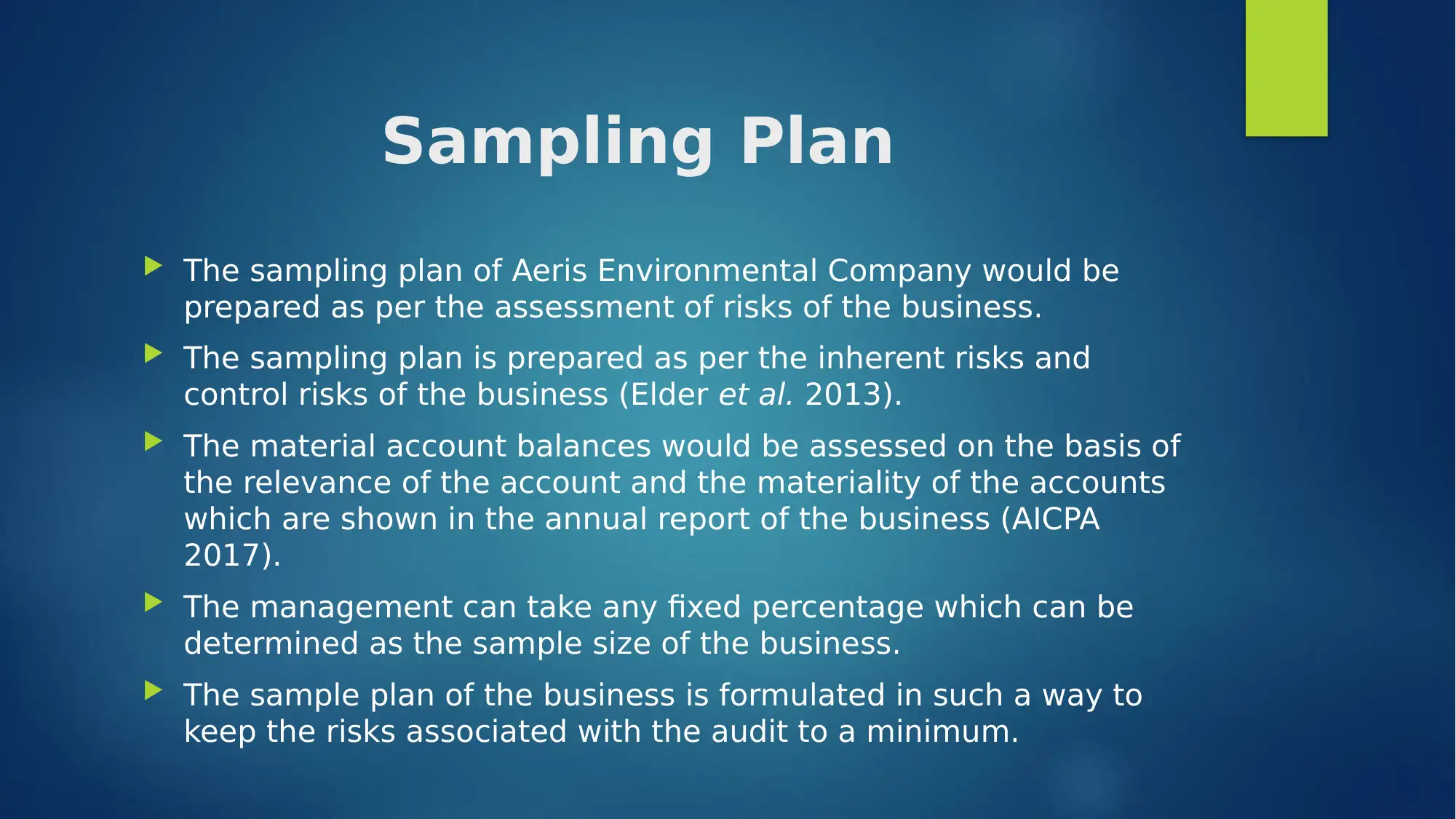
Sampling Plan
The sampling plan of Aeris Environmental Company would be
prepared as per the assessment of risks of the business.
The sampling plan is prepared as per the inherent risks and
control risks of the business (Elder et al. 2013).
The material account balances would be assessed on the basis of
the relevance of the account and the materiality of the accounts
which are shown in the annual report of the business (AICPA
2017).
The management can take any fixed percentage which can be
determined as the sample size of the business.
The sample plan of the business is formulated in such a way to
keep the risks associated with the audit to a minimum.
The sampling plan of Aeris Environmental Company would be
prepared as per the assessment of risks of the business.
The sampling plan is prepared as per the inherent risks and
control risks of the business (Elder et al. 2013).
The material account balances would be assessed on the basis of
the relevance of the account and the materiality of the accounts
which are shown in the annual report of the business (AICPA
2017).
The management can take any fixed percentage which can be
determined as the sample size of the business.
The sample plan of the business is formulated in such a way to
keep the risks associated with the audit to a minimum.
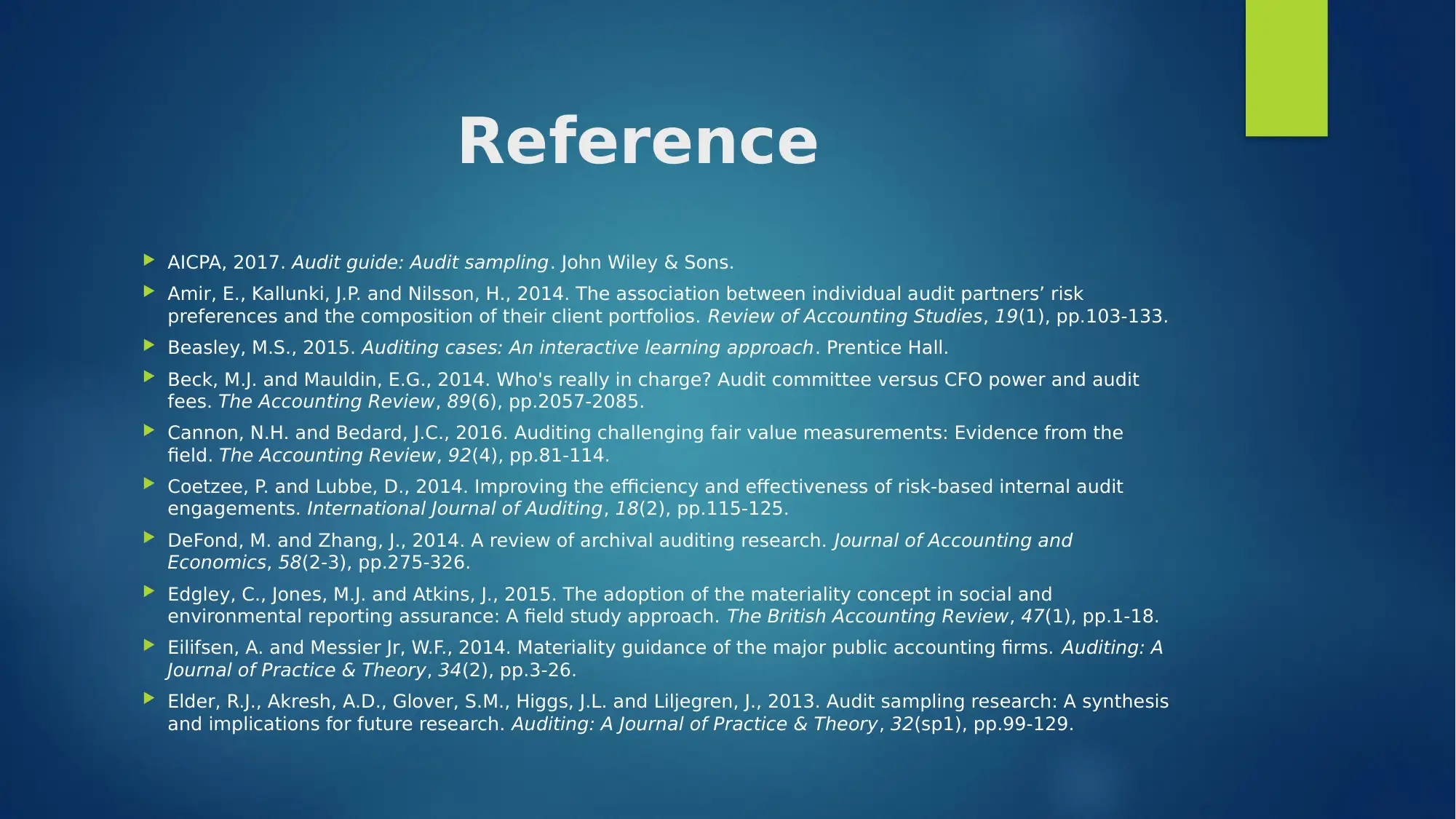
Reference
AICPA, 2017. Audit guide: Audit sampling. John Wiley & Sons.
Amir, E., Kallunki, J.P. and Nilsson, H., 2014. The association between individual audit partners’ risk
preferences and the composition of their client portfolios. Review of Accounting Studies, 19(1), pp.103-133.
Beasley, M.S., 2015. Auditing cases: An interactive learning approach. Prentice Hall.
Beck, M.J. and Mauldin, E.G., 2014. Who's really in charge? Audit committee versus CFO power and audit
fees. The Accounting Review, 89(6), pp.2057-2085.
Cannon, N.H. and Bedard, J.C., 2016. Auditing challenging fair value measurements: Evidence from the
field. The Accounting Review, 92(4), pp.81-114.
Coetzee, P. and Lubbe, D., 2014. Improving the efficiency and effectiveness of risk‐based internal audit
engagements. International Journal of Auditing, 18(2), pp.115-125.
DeFond, M. and Zhang, J., 2014. A review of archival auditing research. Journal of Accounting and
Economics, 58(2-3), pp.275-326.
Edgley, C., Jones, M.J. and Atkins, J., 2015. The adoption of the materiality concept in social and
environmental reporting assurance: A field study approach. The British Accounting Review, 47(1), pp.1-18.
Eilifsen, A. and Messier Jr, W.F., 2014. Materiality guidance of the major public accounting firms. Auditing: A
Journal of Practice & Theory, 34(2), pp.3-26.
Elder, R.J., Akresh, A.D., Glover, S.M., Higgs, J.L. and Liljegren, J., 2013. Audit sampling research: A synthesis
and implications for future research. Auditing: A Journal of Practice & Theory, 32(sp1), pp.99-129.
AICPA, 2017. Audit guide: Audit sampling. John Wiley & Sons.
Amir, E., Kallunki, J.P. and Nilsson, H., 2014. The association between individual audit partners’ risk
preferences and the composition of their client portfolios. Review of Accounting Studies, 19(1), pp.103-133.
Beasley, M.S., 2015. Auditing cases: An interactive learning approach. Prentice Hall.
Beck, M.J. and Mauldin, E.G., 2014. Who's really in charge? Audit committee versus CFO power and audit
fees. The Accounting Review, 89(6), pp.2057-2085.
Cannon, N.H. and Bedard, J.C., 2016. Auditing challenging fair value measurements: Evidence from the
field. The Accounting Review, 92(4), pp.81-114.
Coetzee, P. and Lubbe, D., 2014. Improving the efficiency and effectiveness of risk‐based internal audit
engagements. International Journal of Auditing, 18(2), pp.115-125.
DeFond, M. and Zhang, J., 2014. A review of archival auditing research. Journal of Accounting and
Economics, 58(2-3), pp.275-326.
Edgley, C., Jones, M.J. and Atkins, J., 2015. The adoption of the materiality concept in social and
environmental reporting assurance: A field study approach. The British Accounting Review, 47(1), pp.1-18.
Eilifsen, A. and Messier Jr, W.F., 2014. Materiality guidance of the major public accounting firms. Auditing: A
Journal of Practice & Theory, 34(2), pp.3-26.
Elder, R.J., Akresh, A.D., Glover, S.M., Higgs, J.L. and Liljegren, J., 2013. Audit sampling research: A synthesis
and implications for future research. Auditing: A Journal of Practice & Theory, 32(sp1), pp.99-129.
⊘ This is a preview!⊘
Do you want full access?
Subscribe today to unlock all pages.

Trusted by 1+ million students worldwide

Thank You
1 out of 10
Related Documents
Your All-in-One AI-Powered Toolkit for Academic Success.
+13062052269
info@desklib.com
Available 24*7 on WhatsApp / Email
![[object Object]](/_next/static/media/star-bottom.7253800d.svg)
Unlock your academic potential
Copyright © 2020–2025 A2Z Services. All Rights Reserved. Developed and managed by ZUCOL.





